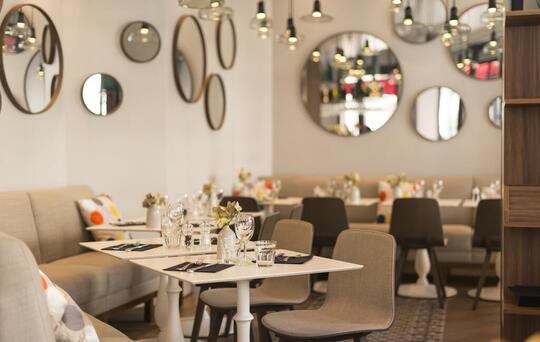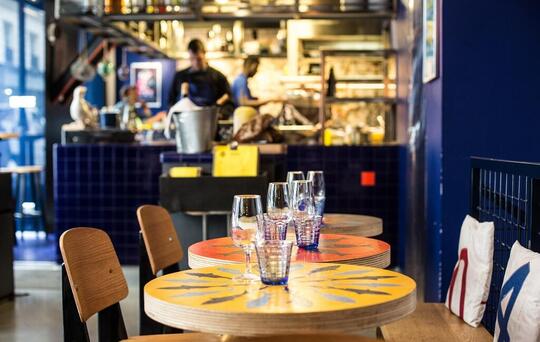Table Turnover : how to calculate it and optimize it ?

- • As dining demand rises, understanding table turnover rate can be a true asset in helping maximize your restaurant revenue and welcome as many diners as possible during all times of the day.
- • How to Calculate Table Turnover
- • Increasing turnover through smoother processes
- • Avoid seating incomplete parties
- • Enroll in TheFork Festival
- • Be creative in encouraging guests not to stay seated very long after dining
- • Make the most of seating arrangements and dining layout
As dining demand rises, understanding table turnover rate can be a true asset in helping maximize your restaurant revenue and welcome as many diners as possible during all times of the day.
Optimizing and understanding average table turnover rate can sometimes be tricky, as you want to turn your restaurant tables as quickly as possible while also avoiding rushing or adding pressure to your diners. Placing too little attention on table turnover can invite a decrease in revenue potential as well as dining satisfaction. Finding the perfect middle point between giving your diners an adequate amount of time to dine and not losing time with long and drug out wait times between parties is the trick. Fortunately, there are some simple subtle ways that you can calculate and optimize your restaurant table turnover while keeping diners equally as satisfied.
How to Calculate Table Turnover
Calculating average table turnover rate is fairly simple as you just want to uncover how many guests you were able to seat in a given dining time.
You can calculate by day or by dining time which is a little more specific and efficient.
For example
In order to calculate average table turnover rate during your dinner hours, you will need to divide the number of dining parties seated by the number of available tables at the end of the dinner period.
If you have 10 tables , and you seated 30 parties, your table turnover will be 3.
Creating table turnover goals and measuring success can vary as every dining experience differs. In order to see what the optimal time your diner might need in your restaurant, you can calculate the turnaround time. The table turnaround time is how long a diner spends in your restaurant from the moment they sit to the moment they leave. Take a few days to analyze this at your different dining times to find an average, and with that you can better understand your table turnover success and goals. However, table turnover can always be optimized to ensure you are getting maximum results and revenue.
Increasing turnover through smoother processes
One thing Covid taught the industry is technology and processes can make everyone's life easier. Making sure your restaurant is time efficient in every step is key to encouraging better table turnover.
Increased staff awareness for quicker response times
Being sure your staff is always scheduled to match demand and proactive in greeting and seating guests as soon as possible is an important step as the dead time in these moments can really affect table turnover. Not only will quicker greetings, quicker seatings, and quicker responses to diners optimize table turnover but it will also increase diner satisfaction.
Going Digital
Many restaurants have already taken advantage of digital menus and digital payment solutions, and for good reason, as these additions to your restaurant can play a big role in table turnover. With diners having access to your menus right away and even before being seated as they wait, they are much more likely to know and make their order much quicker.
Digital mobile payment solutions like TheFork Pay are great tools to implement into your restaurant as diners no longer have to wait for payments to be processed in the case the staff is very busy or they would just like to complete their payment earlier than expected.
Avoid seating incomplete parties
Whether it is an online reservation, call in, or party without a reservation, you want to try and avoid seating parties prematurely before the complete party has arrived. Seating parties before everyone has arrived will have a negative impact on table turnaround and turnover. To decrease irritants for diners around this topic, be sure to alert diners you can only seat complete parties, but more specifically when you are at maximum occupancy.
Be creative in encouraging guests not to stay seated very long after dining
While you never want to rush your guests or be pushy, sometimes guests don’t realize how much time they have spent in the restaurant after completing their meal. During busy times, try offering your diners bar seating if available or checking in to ask if they have completed dining or would like to order something in addition. As long as you remain high-spirited and kind with your diners, they will be very understanding. These subtleties will allow the diner to realize on their own they may be all set head home.
Make the most of seating arrangements and dining layout
Making sure your dining room and patio are utilizing all of the space available is a sure positive way to optimize table turnover. In addition, seating parties appropriately to size is very important. Utilize digital seating optimization like TheFork Manager which will aid in seating parties that make reservations to ensure your seating plan is efficient and effective while also providing the flexibility to view and adjust your seating plan in real time.
Even in times that are not so busy , try to keep parties of 2 at tables with seating for two as you never know when demand could pick up throughout the day and a true party of 4 will arrive needing that seating.
Make the most of these tips and find restaurant specific tips and tricks that work to optimize your table turnover. Once you have understood how to calculate and optimize your table turnover you can look forward to better restaurant flow and increased revenue.
- As dining demand rises, understanding table turnover rate can be a true asset in helping maximize your restaurant revenue and welcome as many diners as possible during all times of the day.
- How to Calculate Table Turnover
- Increasing turnover through smoother processes
- Avoid seating incomplete parties
- Enroll in TheFork Festival
- Be creative in encouraging guests not to stay seated very long after dining
- Make the most of seating arrangements and dining layout














